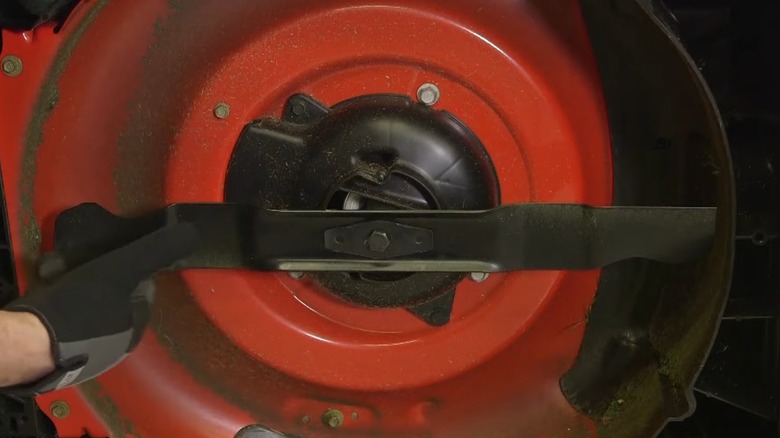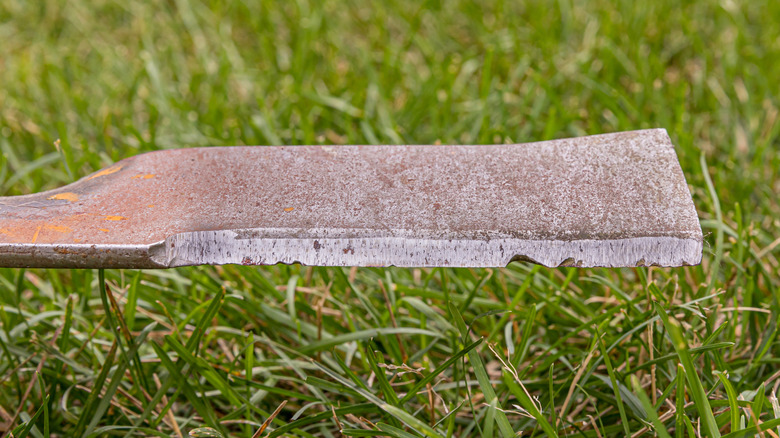Yes, Some Lawn Mower Blades Are Reverse Threaded - Here's Why It's Important
Mower blades themselves aren't threaded, but rather the fastener that holds the blade in place can be either right or left-threaded. Right-hand threaded fasteners tighten clockwise and loosen counter-clockwise, with the saying, "righty tighty, lefty loosey," ringing true. However, some mower blades are affixed using a left-hand or reverse threading, which tightens counter-clockwise and loosens clockwise. Reverse-threaded fasteners, which hold some mower blades in place, are used to enhance safety.
Most mower blades turn clockwise, and it's easy to identify which direction your blades spin by noticing which side the grass discharge chute is located. For example, while standing behind the mower or sitting in the seat of a riding mower, if the chute is on the right side, the blades spin clockwise (when looking down from above or counter-clockwise if you were able to look up from underneath). A reverse-threaded fastener tightens in the same direction the blade is spinning; thus, it can't loosen during operation.
How to know if your mower blade fastener is reverse threaded, and how to properly tighten a blade that's not
Some, not all, mower blades incorporate reverse-threaded fasteners, so you'll want to know if your mower is one of them before you start potentially applying torque in the wrong direction. The best way to identify if your blade is attached using a reverse-threaded bolt is to check your machine's manual. You also may be able to spot it while examining the underside of the mower. However, oftentimes it can be a mess of stuck-on grass clumps and dirt, making it difficult to see. Fortunately, there is a handy WD-40 hack that will extend the life of your lawn mower and tidy things up underneath the cutting deck.
If your mower uses the typical right-handed thread, as with replacing any blades, you need to tighten to the manufacturer's specified setting. This requires a torque wrench, which allows you to specify how many foot-pounds of torque you place on the fastener. The exact figure for your mower should be available in the manual and will help ensure the blade is secure before operation. For example, Cub Cadet's Enduro XT2 LX 42 – 24HP Kawasaki riding mower notes in the manual that it uses a normal thread pattern (right-handed) and should be tightened to a setting of anywhere from 90 to 110 foot-pounds.
Why it's important to change out your mower blades
While swapping out your lawn mower's blades can be an inconvenience, particularly for riding and zero-turn models that may require you to detach the cutting deck, it's an important part of maintenance. Dull blades on your mower can force the engine to work harder and use more gasoline. If you continue to overtax your mower's engine, this could lead to earlier and more frequent repairs.
Beyond the machine itself, unsharpened or jagged blades will not only provide a poorer cut, potentially leaving clumps behind, but they will also damage your lawn. Instead of cleanly slicing through the grass, a dull blade actually rips and tears apart the turf. The result can be noticeable brown coloration, which can be more pronounced in certain areas. This unhealthy grass then becomes an easier target for certain diseases.
When blades become dull, you have a few different options for addressing the situation. You can purchase new blades from the hardware store, but you'll need to ensure they are the correct size and compatible with your mower model. Alternatively, you can pick up a tool for sharpening dull lawn mower blades and get them in optimal shape.


